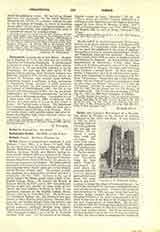

Corbie (CORBY Or CORBINGTON), AMBROSE, b. near Durham, December 7, 1604; d. at Rome, April 11, 1649. He was the fourth son of Gerard Corbie and his wife Isabella Richardson, exiles for the Faith. Of their children, Ambrose, Ralph, and Robert, having become Jesuits (Richard died as a student at St.-Omers, and the two surviving daughters, Mary and Catherine, became Benedictine nuns at Brussels), the parents by mutual agreement entered religion. The father entered the Society of Jesus as a lay brother in 1628, and having reconciled his father Ralph (aged 100) to the Church, died at Watten, September 17, 1637. The mother, in 1633, was professed as a Benedictine at Ghent and died a centenarian, December 25, 1652. Ambrose at the age of twelve entered St.-Omers, going thence (1622) to the English College, Rome. He entered the Society of Jesus at Watten in 1627, and in 1641 was professed. Having taught with success for some years at St.-Omers, and been minister at Ghent in 1645, he was appointed confessor at the English College, Rome, where he died in his forty-fifth year. His works are: (I) “Certamen Triplex” etc., the history of the martyrdom of three English Jesuit priests: Thomas Holland, his own brother Ralph Corbie (see below), and Henry Morse (Antwerp, 1645, 12mo), with three engraved portraits; reprinted (Munich, 1646, 12mo); English translation by E. T. Scargill under the title of “The Threefold Conflict”, etc.; ed. W. T. Turnbull (London, 1858, 8vo). (2) An account of his family; English version in Foley, “Records”, III, 64. (3) “Vita e morte del Fratello Tomaso Stilintono [i.e. Stillington alias Oglethorpe] novitio Inglese della Cornpagnia di Gesu morto in Messina, September 15, 1617”; (MS. at Stoneyhurst College; see “Hist. MSS. Comm.”, 3rd Report, 338, tr. and ed. Foley, “Records”, III, 15 sqq.
RALPH (called at times CORBINGTON), VENERABLE, brother of the above, martyr-priest, b. March 25, 1598, near Dublin; d. September 7, 1644. From the age of five he spent his childhood in the north of England, then going over seas he studied at Saint-Omer, Seville, and Valladolid, where he was ordained. Having become a Jesuit about 1626, he came to England in 1631 and labored in Durham. He was seized by the Parliamentarians at Hamsterley, July 8, 1644, when clothed in his Mass vestments, conveyed to London, and committed to Newgate (July 22), with his friend John Duckett, a secular priest. At their trial (Old Bailey, September 4) they both admitted their priesthood, were condemned to death, and executed at Ty-burn. September 7. Stonyhurst has a relic of Father Corbie; for the Duke of Gueldres’ attestation in 1650 of other relics, see Foley’s “Records S. J.”, I, 564; the “Certamen” portrait is reproduced in “Records”, VII (I), 168; for his letters, see vol. III, 69 sqq., of the same work. The Corbie alias, according to Foley [op. cit., VII (II), 898] was Carlington or Carlton.
PATRICK RYAN

